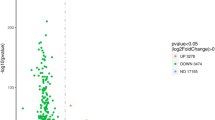Abstract
Background
The acute hypoxic injury caused by the plain population entering the plateau in a short period of time has become the main cause of endangering the health of the people who rush into the plateau.
Objective
The study aimed to identify the key genes which participate in resisting the acute hypoxic injury in SD Rats by transcriptomic profile analysis.
Methods
48 Sprague Dawley (SD) male rats were enrolled and randomly divided into four groups (0h, 24h, 48h, 72h) and housed in hypobaric hypoxia chamber with altitude 6000m for different periods of time to make them acute hypoxic injury. The transcriptomic profile of the lung tissue of the rats was analysed by RNA second-generation sequencing combined with bioinformatics analysis.
Results
The results of GO and KEGG function classification analysis revealed that the differential expression genes enriched in steroid hormone synthesis pathway especially in 48h group compared to F0 group. Further analysis revealed that Farnesyl Diphosphate Farnesyl Transferase 1 (fdft1) gene encoding a rate-limiting enzyme in steroid hormone synthesis pathway was significant differently expressed between the groups. The expression levels of fdft1 gene were further verified by RT-PCR and Western-blot methods.
Conclusions
The results suggest that fdft1 gene plays an important role in responding to acute hypoxic injury by regulating steroid hormone biosynthesis.




Similar content being viewed by others
References
Agorreta J, Garayoa M, Montuenga LM et al (2003) Effects of acute hypoxia and lipopolysaccharide on nitric oxide synthase-2 expression in acute lung injury. Am J Respir Crit Care Med 168(3):287–296
Agorreta J, Zulueta JJ et al (2005) Adrenomedullin expression in a rat model of acute lung injury induced by hypoxia and LPS. Am J Physiol Lung Cell Mol Physiol 288(3):536–545
Anders C, Niewoehner O, Duerst A, Jinek M (2014) Structural basis of PAM-dependent target DNA recognition by the Cas9 endonuclease. Nature 513:569–573
Basnyat B, Murdoch DR (2003) High-altitude illness. Lancet 361(9373):1974
Brtsch P (2015) The brain in acute mountain sickness and cerebral edema. J Neurol Sci 357:e504
Droma Y, Hanaoka M, Ota M et al (2002) Positive association of the endothelial nitric oxide synthase gene polymorphisms with high-altitude pulmonary edema. Circulation 106:826–830
Eltzschig HK, Carmeliet P (2011) Hypoxia and inflammation. N Engl J Med 364:656–665
Hanaoka M, Tanaka M, Ge RL et al (2000) Hypoxia-induced pulmonary blood redistribution in subjects with a history of high-altitude pulmonary edema. Circulation 101:1418–1422
Hartmann G, Tschöp M, Fischer R et al (2000) High altitude increases circulating interleukin-6, interleukin-1 receptor antagonist and C-reactive protein. Cytokine 12:246–252
Kamonshanok K, Saovaros S, Jarinthorn T et al (2016) Hepcidin and 1,25(OH)2D3 effectively restore Ca2+ transport in β-thalassemic rats: reciprocal phenomenon of Fe2+ and Ca2+ absorption. Am J Physiol Endocrinol Metab 311:E214–E223
Krebs J, AgellonL B, Michalak M (2015) Ca2+ homeostasis and endoplasmic reticulum (ER) stress: an integrated view of calcium signaling. Biochem Bioph Res Co 460:114–121
Li YH, Tana W, Bai ZZ et al (2018) Transcriptomic profiling reveals gene expression kinetics in patients with hypoxia and high altitude pulmonary edema. Gene 651:200–205
Luo Y, Zou Y, Gao Y (2012) Gene Polymorphisms and high-altitude pulmonary edema susceptibility: a 2011 update. Respiration 84:155–162
Maggiorini M (2006) Both tadalafil and dexamethasone may reduce the incidence of high-altitude pulmonary edema. Ann Intern Med 145(7):497
Mishra KP, Sharma N, Soree P (2016) Hypoxia-induced inflammatory chemokines in subjects with a history of high-altitude pulmonary edema. Indian J Clin Biochem 31:81–86
Mortimer H, Patel S, Peacock AJ (2004) The genetic basis of high-altitude pulmonary edema. Pharmacol Ther 101:183–192
Murray F, Insel PA, Yua JX (2006) Role of O2 K+ and Ca2+-sensitive channels in the regulation of the pulmonary circulation: potential role of caveolae and implications for high altitude pulmonary edema. Respir Physiol Neurobiol 151:192–208
Neeck G, Renkawitz R, Eggert M (2002) Molecular aspects of glucocorticoid hormone action in rheumatoid arthritis. Cell Mol Ther 7:61–69
Sartori C, Allemann Y, Duplain H et al (2002) Salmeterol for the prevention of high-altitude pulmonary edema. New Engl J Med 346:1631–1636
Sergeev I (2013) Regulation of apoptosis in adipocytes and breast cancer cells by 1,25-dihydroxyvitamin D3: a link between obesity and breast cancer. Horm Mol Biol Clin Investig 14:99–106
Stream JO, Grissom CK (2008) Update on high-altitude pulmonary edema: pathogenesis, prevention, and treatment. Wilderness Environ Med 19:293–303
Tang E, Yu C, Luo Y (2014) Dexamethasone for the prevention of acute mountain sickness: systematic review and meta-analysis. Int J Cardiol 173:133–138
Voelkel NF (2002) High-altitude pulmonary edema. New Engl J Med 346:1606–1607
Weng ML, Chen WK, Chen XY et al (2020) Fasting inhibits aerobic glycolysis and proliferation in colorectal cancer via the Fdft1-mediated AKT/mTOR/HIF1α pathway suppression. Nat Commun 11(1):1869
Yarnell PR, Heit J, Hackett PH (2000) High-altitude cerebral edema (HACE): the denver/front range experience. Semin Neurol 20:209–218
Funding
This research was supported by the Second Tibetan Plateau Scientific Expedition and Research Program (STEP), Grant No. 2019QZKK0606, Project 31660254 of the Chinese National Natural Science Foundation, Project 2017-ZJ-Y13 of the Key Laboratory of Medicinal Animal and Plant resources of the Qinghai-Tibetan Plateau, Projects 2019-ZJ-7042 of the Department of Science and Technology of Qinghai Province, Projects 201910743003 of National Students’ Platform for Innovation and Entrepreneurship Training Program.
Author information
Authors and Affiliations
Corresponding author
Ethics declarations
Conflict of interest
The authors declare that there is no conflict of interest.
Ethics and consent statement
The animals involved in the study were handled in accordance with the National Regulations on the Administration of Laboratory Animals (GB14923-2010). The animal experiment scheme was approved and examined by the Ethics Committee of School of Medicine of Qinghai University.
Additional information
Publisher's Note
Springer Nature remains neutral with regard to jurisdictional claims in published maps and institutional affiliations.
Electronic supplementary material
Below is the link to the electronic supplementary material.
Rights and permissions
About this article
Cite this article
Lin, X., Wang, H. & Pu, X. Protective mechanism of fdft1 in steroid hormone synthesis pathway in SD rats with acute hypoxic injury. Genes Genom 42, 1319–1326 (2020). https://doi.org/10.1007/s13258-020-00999-5
Received:
Accepted:
Published:
Issue Date:
DOI: https://doi.org/10.1007/s13258-020-00999-5




